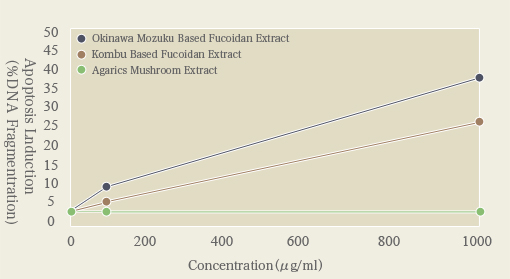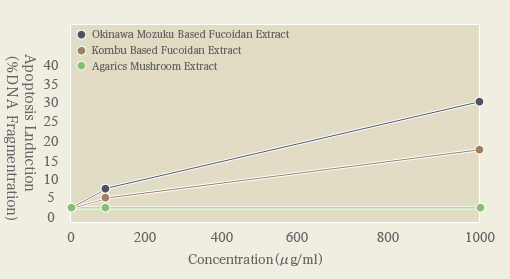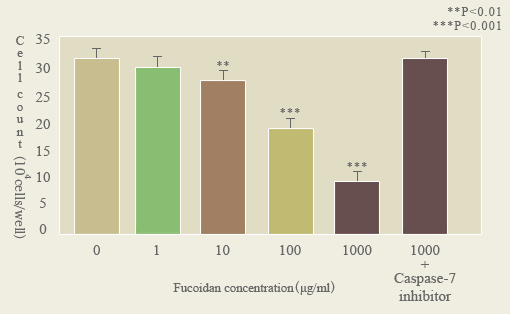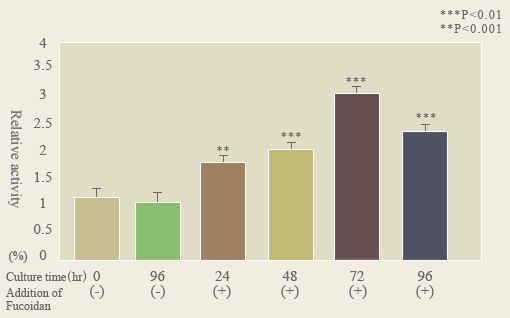 Apoptosis
Apoptosis
▼Induction of Apoptosis
“Apoptosis” is a generally programmed mechanism of cell death. When certain stimulation is applied to a cell, its gene triggers the self destruction device and the cell dies. Once apoptosis occurs to a cell, DNA of cancer cells will be fragmented and disappear.
▼Verification of apoptosis effect
A study on the influence of mozuku (Cladosiphon Okamuranus) derived fucoidan, Mekabu (Undaria Pinnatifida) derived fucoidan and agaricus mycelium extract powder on apoptosis of promyelocytic leukemia cell strains (HL60) and cultured human ovarian tumor cell strains (NOS4) has been carried out. Apoptosis was determined.
・Method of experiment
Applied mozuku (Cladosiphon Okamuranus) derived fucoidan, Mekabu (Undaria Pinnatifida) derived fucoidan and agaricus mycelium extract powder onto each promyelocytic leukemia cell strain (HL60) and cultured human ovarian tumor cell strains (NOS4) and cultured them.

Apoptosis Induction to Promyelocytic Cell Strain(HL60)

Apoptosis Induction to Human Ovarian Tumor Cell(NOS4)
(12th International Congress of Immunology)
Effects of each type of fucoidan and agaricus inducing apoptosis When agaricus was applied to the cancer cell, there was no apoptosis effect. The results did reveal that mozuku derived fucoidan and mekabu derived fucoidan exhibited a high ability to induce apoptosis.
▼Verification of apoptosis induction ability
We examined how mozuku derived fucoidan would affect apoptosis induction on the growth of human breast cancer cell strains (MCF-7).
・Method of experiment
Sample ① mozuku derived fucoidan and ② mozuku derived fucoidan prepared with caspase-7 inhibitors were added to human breast cancer cell strains (MCF-7) and the cells were cultured. As a control, ③ nothing was added to the culture. (Illustration 1)
We examined the activation of caspase-7 after it was added to fucoidan. (Illustration 2)
Caspase ・・・Caspase-7, apoptosis-related cysteine peptidase, and Caspase-7 is a member of the caspase (cysteine aspartate protease) family of proteins, and has been shown to be an executioner protein of apoptosis. Sequential activation of caspases plays a central role in the execution-phase of cell apoptosis. Caspases exist as inactive proenzymes which undergo proteolytic processing by upstream caspases (caspase-8, -9) at conserved aspartic residues to produce two subunits, large and small, that dimerize to form the active enzyme in the form of a heterotetramer.

Suppression of MCF-7 Cell Growth(Illustration 1)

Caspase-7(Illustration 2)
Effects of mozuku derived fucoidan inducing apoptosis
Once fucoidan was presented to the cancer cells, human breast cancer cells had a decrease of density dependence. When fucoidan 1000 μg was presented to human breast cancer cells, cancer cells were decreased, however breast cancer cells did not change when fucoidan 1000 μg with caspase-7 inhibitor was presented. (Illustration 1)
Therefore we thought that mozuku derived fucoidan induced apoptosis when activate caspase-7. So, then we measured caspase-7, caspase-7 was activated by fucoidan. (Illustration 2)
Today, active research is conducted on fucoidan and various bioactive functions of fucoidan, such as “anti-cancer action,” “cholesterol-lowering action,” “blood-pressure lowering action” and “anti-virus action,” have been revealed.
 NPO Research Institute of Fucoidan
NPO Research Institute of Fucoidan Activation of immune system
Activation of immune system